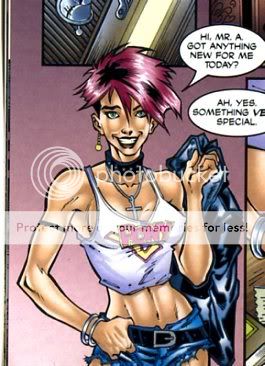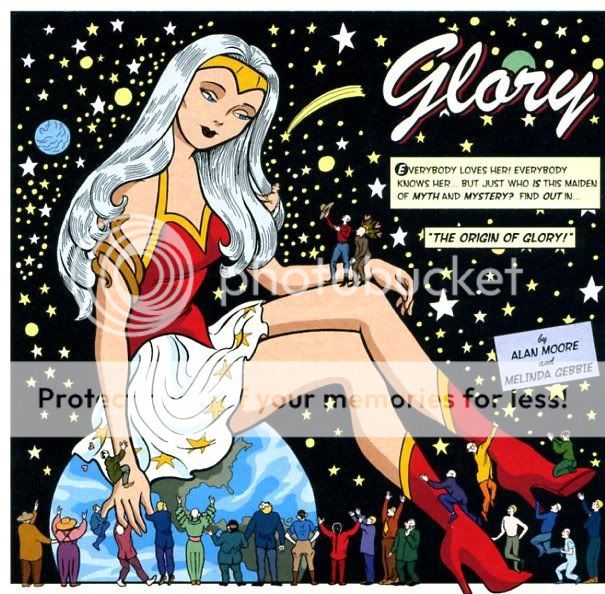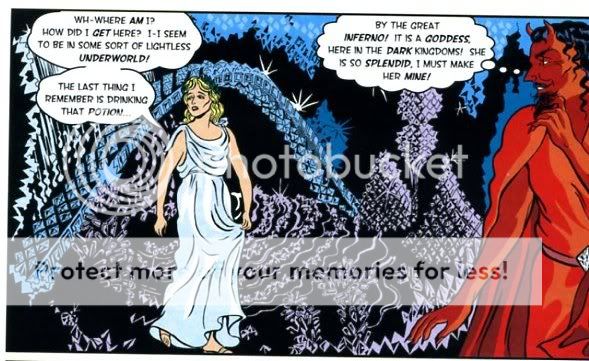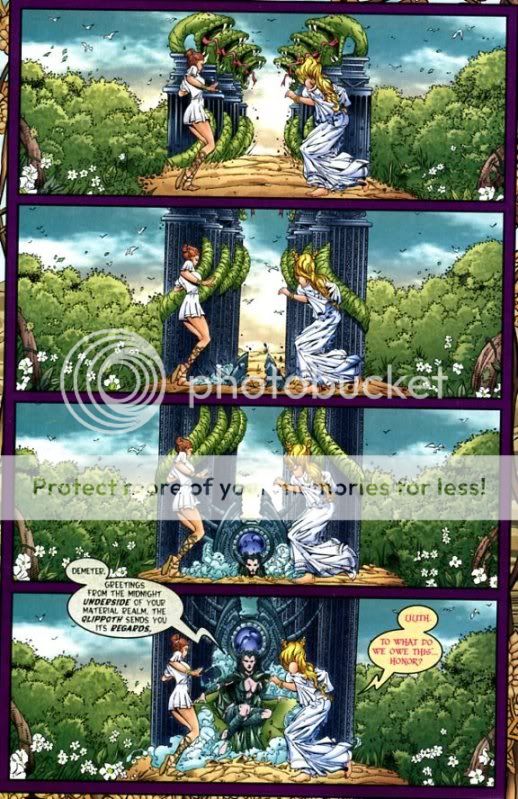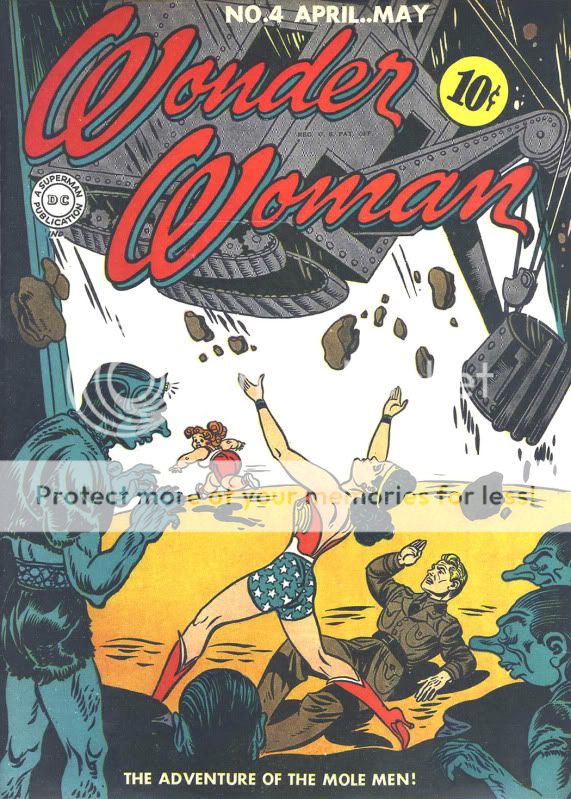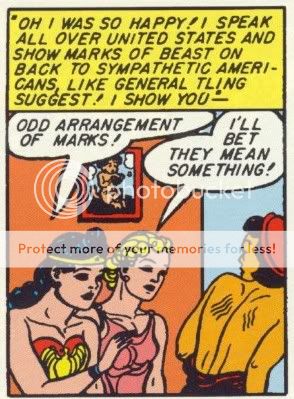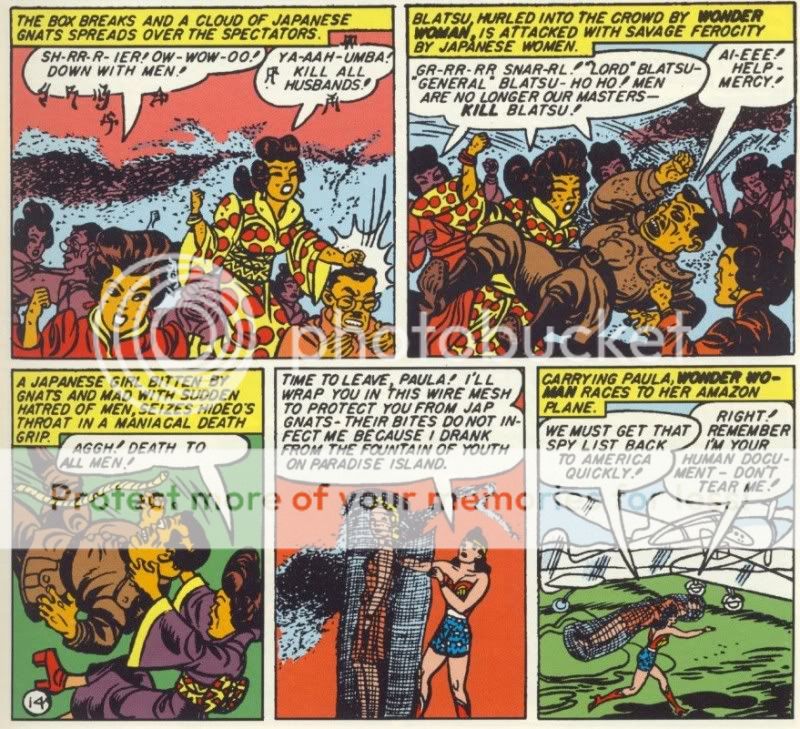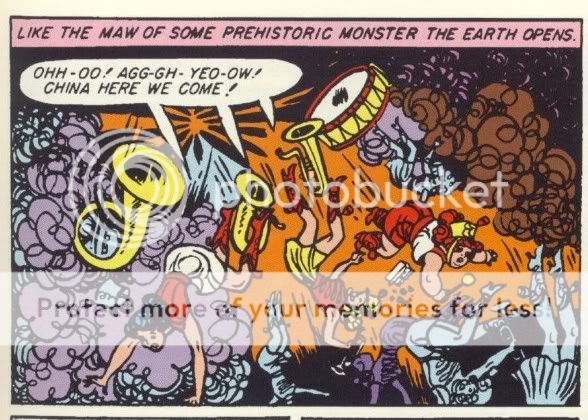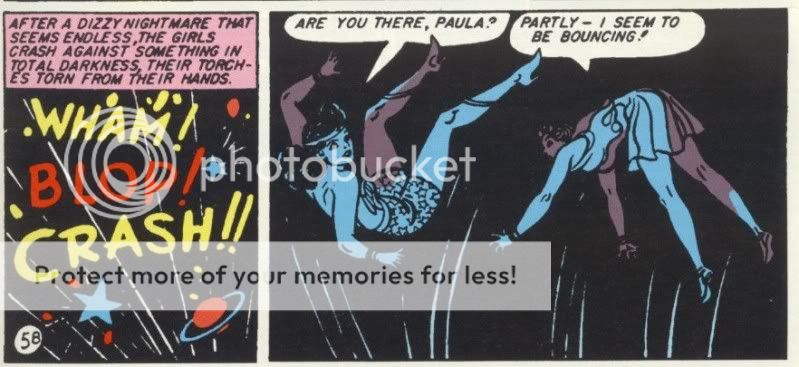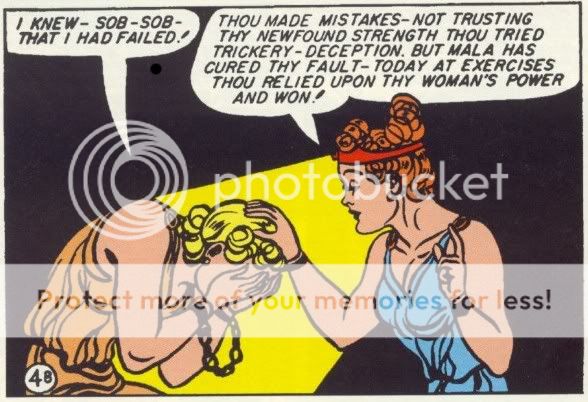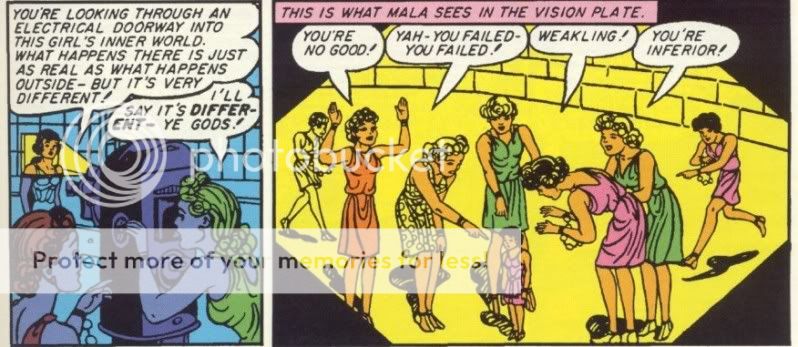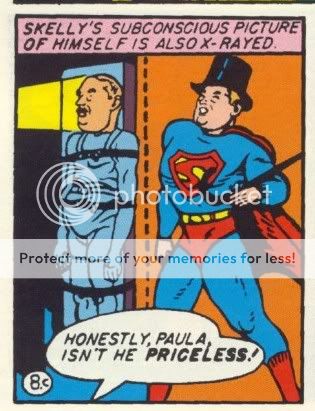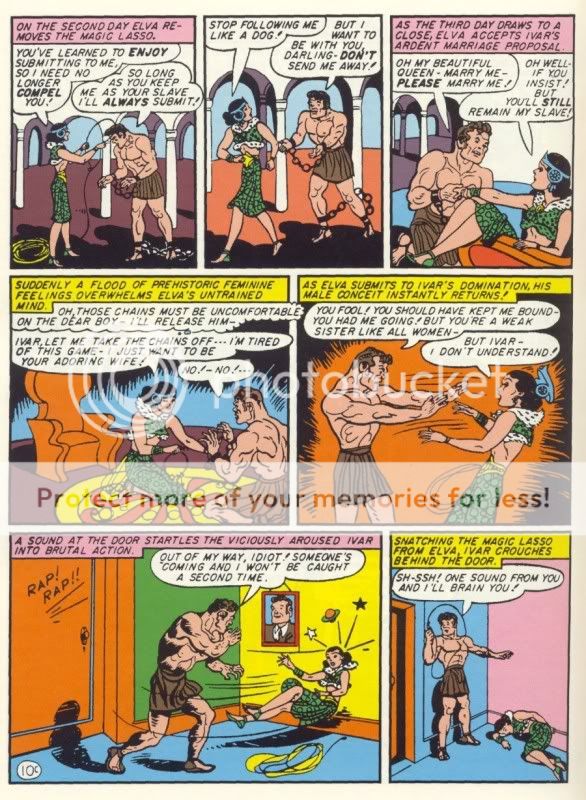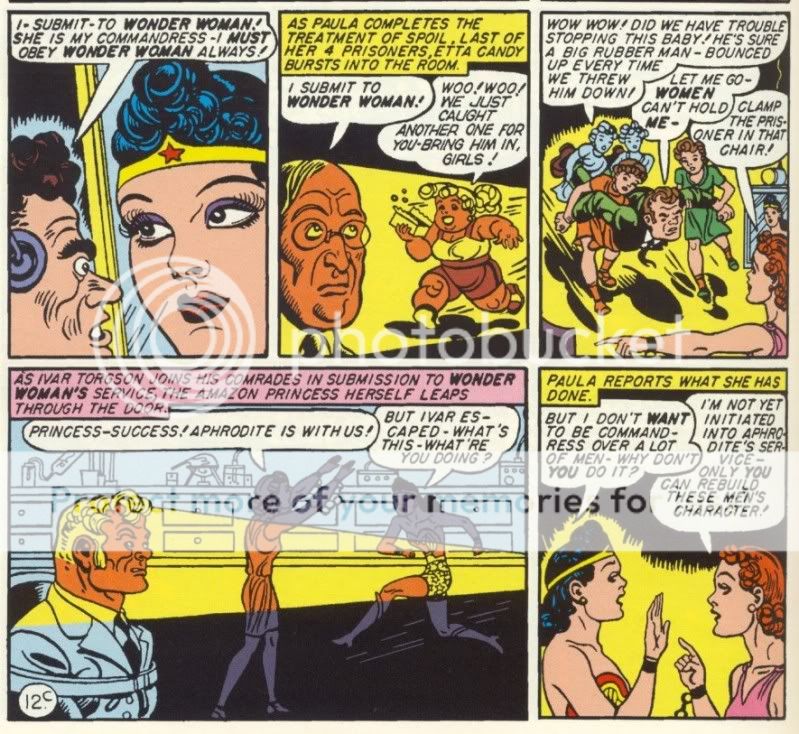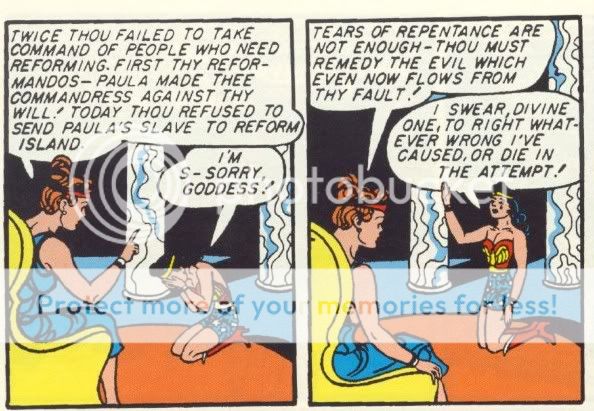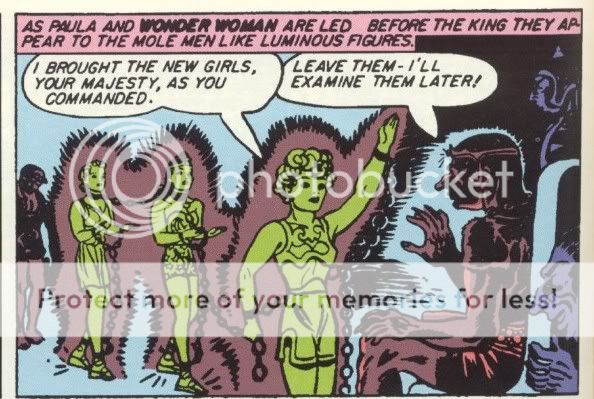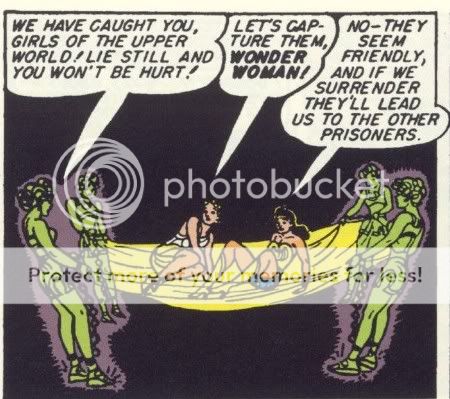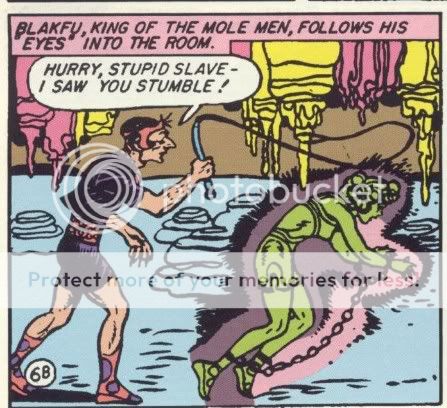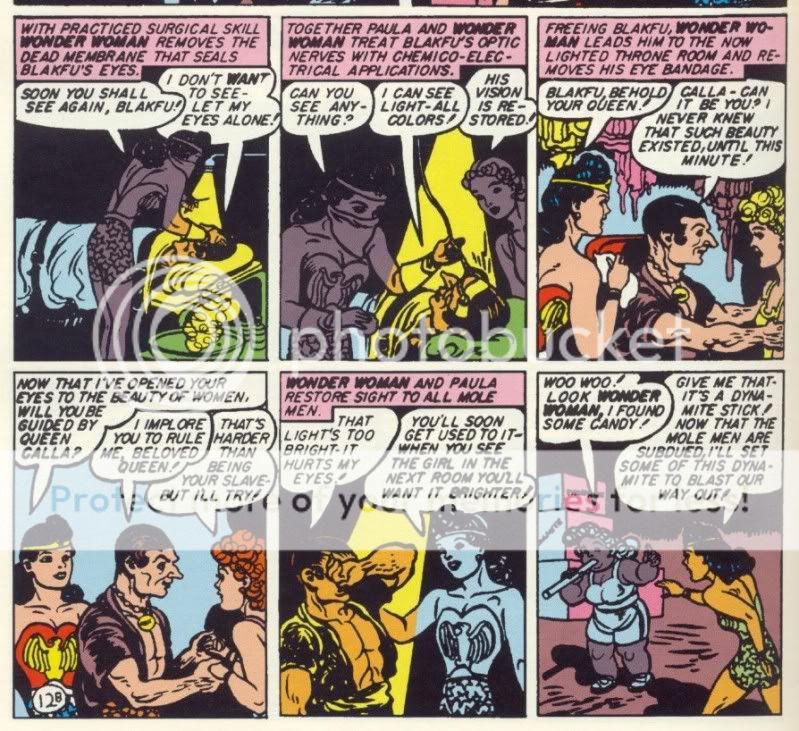I’d posted a bit back about Alan Moore’s proposal for Glory. Basically I argued that for the most part Moore didn’t seem to understand what made the Marston/Peter run great; in his proposal he tended to take weird, absurd ideas (like the invisible plane), note that they were weird and absurd, and then go on to suggest changing them in ways that made them more conventional and boring (turning the invisible plane into a more mythologically appropriate, and therefore less goofy, transforming chariot thingee, for example.)
Well, my brother very kindly sent me the three issues of Glory that Moore actually wrote (numbered 0, 1, 2) — and I was pleasantly surprised. I think the actual book is a good bit better than the proposal.
Not that Moore has suddenly figured out the Marston/Peter run. There’s no particular evidence that he has. Rather, it’s that, despite some lip service to the WW history and mythos, he really largely manages to ignore Marston and get on with his own ideas. For instance, I noted that the most interesting part of the proposal seemed to be Moore’s ideas about Glory’s secret identity. WW did have a secret identity in the Marston run, of course, but it always seemed tacked on — there because super-heroes were supposed to have secret identities rather than because it was an integral part of Marston’s politics or fetishes. WW always seemed to be slumming as Diana Prince — presumably because she wanted to be near Steve Trevor…but since WW always hung out with Steve Trevor anyway, the motivation didn’t seem especially coherent.
For Moore, however, the secret identity expands and becomes essentially the entire point of the book (or of the couple of issue he wrote anyway). Glory wants to know what it’s like to be human — which isn’t an original trope, exactly. But the trick is that the person she chooses to become/inhabit, Gloria, is a waitress who’s a schizophrenic. She’s Gloria’s secret identity, and Glory is her fantasy. The tension between those two perspectives is funny and poignant and even a little disturbing, especially at the cliff-hanger ending (never resolved), where the gap between Glory and Gloria, or between imagination and reality, swallows both of them up.
In the proposal, Moore suggested that the comic should be “disingenuous” and “coy” in its portrayal of cheesecake, lesbian subtext, sex, and so forth. I felt that this was really a fundamental misunderstanding of Marston, and overall just not a good way to go. And, indeed, the moments where the series goes that direction are, in general, not of the best. In issue #0, for example, there’s a flashback/retelling of Glory’s history which includes a lot of badly-rendered gratuitous cheesecake which is irritating and dull. And then there’s the cameo by a female comic reader in a half-shirt who a skeevy old book-retailer keeps refers to as “child”, and who behaves more or less like a kid (deferential to old skeevy guy, eager for new book,…she’s an analogue to that comic-reading kid in Watchmen, actually), but who has the hard-bodied, half-shirted, butt-falling-out-of-her-bottoms look of a poorly-drawn pin-up.
On the other hand, the retro-bondage flashback story in issue #2 with cross-dressing, serious butch-femme play, and tongue-in-cheek parodically second-wave sneering at the bonds of matrimony was quite entertaining…though its knowing satire, its exploitation, and its clever plotting with the twist ending is world’s away from Marston/Peter (it reads much more like Moore’s own efforts for 2000 AD, actually, albeit with less explicit violence and more implicit sex.)
In any case, the point is, these are largely aberrations; the bulk of the series doesn’t go for coy or disingenuous or cheesecake especially. Instead, it treats sex and love in an above-board, respectful manner. Gloria the waitress sleeps with a marginal drifter character, and its sweet and sexy and cute (“I like his name and how he talks,” Glory thinks, “I like his bottom.”) Similarly, Hermione, Glory’s companion, has an unrequited crush on her…Moore threatened to mine that for titillation in the proposal, but in the actual comic it’s played almost entirely for bittersweet pathos. Maybe Moore wrote the proposal figuring that Liefield wanted coy cheesecake? In any case, there’s much less of it in the comic than he promised, which is all to the good.
Overall, I think the fact that this isn’t actually Wonder Woman helped Moore a good bit. Glory’s costume is no great shakes, but it’s not the dreaded swimsuit of Americana. She isn’t tricked out with bondage gear. She doesn’t have tons of baggage about, for example, the mission of peace (Moore basically has her going to man’s world initially because Hitler pisses Demeter off by being a jerk, and later just because she feels like it), or feminism (which Moore uses as an off-hand joke a couple of times, but doesn’t otherwise bother with.) There isn’t any need to make any homage to the idea that she’s an icon of any sort. Though he takes some things from the WW mythos, Glory ends up as much less WW than Supreme was Superman. Instead of fetish and feminism, Moore uses the title to talk about magic, imagination, and relationships — his obsessions, not Marston’s at all.
Maybe this is clearest in the retelling of Glory’s origin, illustrated by Melinda Gebbie. The first image of the story is this:
This reminded me of the Ms. cover image where WW is shown as a giant. Here, though, the sexualizing effects of manipulating body size are much more thought through and under control; the children’s book stylized whimsy, the girly outfit, the fashion pose, the skin, and the tiny figures showering her with adulation; she’s powerful, but also a sexual object in a whimsical way. I mean, Marston wasn’t exactly whimsical, I don’t think — more cracked. But this seems like a nice nod to his themes; a way to point to them without pretending to take them as seriously as the man himself did. It is coy, I guess, but almost nostalgically or poignantly so — especially as those very elliptically suggested themes of sexual power and submission don’t really play out in the following narrative at all. Instead, the story Moore tells is actually much more like a Neil Gaiman Sandman tale than like a Marston fever dream — it’s a reworking of the Persephone myth, with Demeter impregnated by a demon in the form of a silver rain about halfway thorugh. There’s no bondage or purple healing rays or caricatured masculine stereotypes anywhere in sight. Gebbie’s artwork does share some traits in common with Peter — a somewhat simplified cartoony style, some frilly filigree, a penchant for stiff poses creating frieze-like compositions. Her faces, though, are much more expressive, and her linework less so. The feel ends up being more conventional and sentimental, as in the image below:
I really like that panel, with the diamond patterns in the back and the demon thinking in Lichtenstein melodrama. We get love and mystery and magic. It’s nothing like Marston/Peter, the putative object of the tribute. But that doesn’t mean it’s bad.
This isn’t to say that Glory is overall comparable in quality to the Marston/Peter WW run. In the first place, other than Gebbie’s eight-page cameo, the art is typical mainstream crap; ugly stylistic nullity mottled in that horrible computer coloring. Moore tries for a couple of Winsor McCay effects and you just want to tell him to stop, man; nobody here has the skill for that. You’re just embarrassing everyone. Give it up.
Art problems aside, Moore’s authorial vision, in this title at least, isn’t nearly as weird, as funny, or, I’d argue, as thoughtful as Marston’s original. What with the flashbacks and the backstories and the diner drama and Glory running off to fight badness every so often…the characterization and plot are clever and fun, but they’re too diffuse to really seem urgent or to add up to all that much. As with Supreme, you get the sense that Moore (like Glory) is slumming; running along and entertaining himself without breaking too much of a sweat. The themes around imagination are things we’ve seen from him before…stories affecting the world, stories breaking into the world, etc. etc. In a couple of sequences, characters in the comic are reading comics, and then the comic within a comic turns around and breaks the fourth wall and talks to the character in the comic…and you think, yep, whatever, Alan — comics are a metaphor for existence. Can we move on now?
The thing is, since I don’t find these ideas that compelling in the first place, I’d just as soon see Moore treat them as toss offs; better that than Promethea, certainly. The air of improvisation doesn’t hurt the book;on the contrary, I like the breeziness of it, and there’s still enough depth to keep things engaging and even affecting. It’s not genius, but it is one of the few versions of WW that isn’t an aesthetic pratfall. Marston/Peter’s character is impossible to deal with, and so Moore, very reasonably, refuses to, and comes up with something else entirely.
_________
One complaint though; Moore puts an Etta Candy analogue in one of his flashback stories…and she’s thin and hot! What’s with that? Did Liefield decreed that there couldn’t be any fat women in his comics, no not even one?

